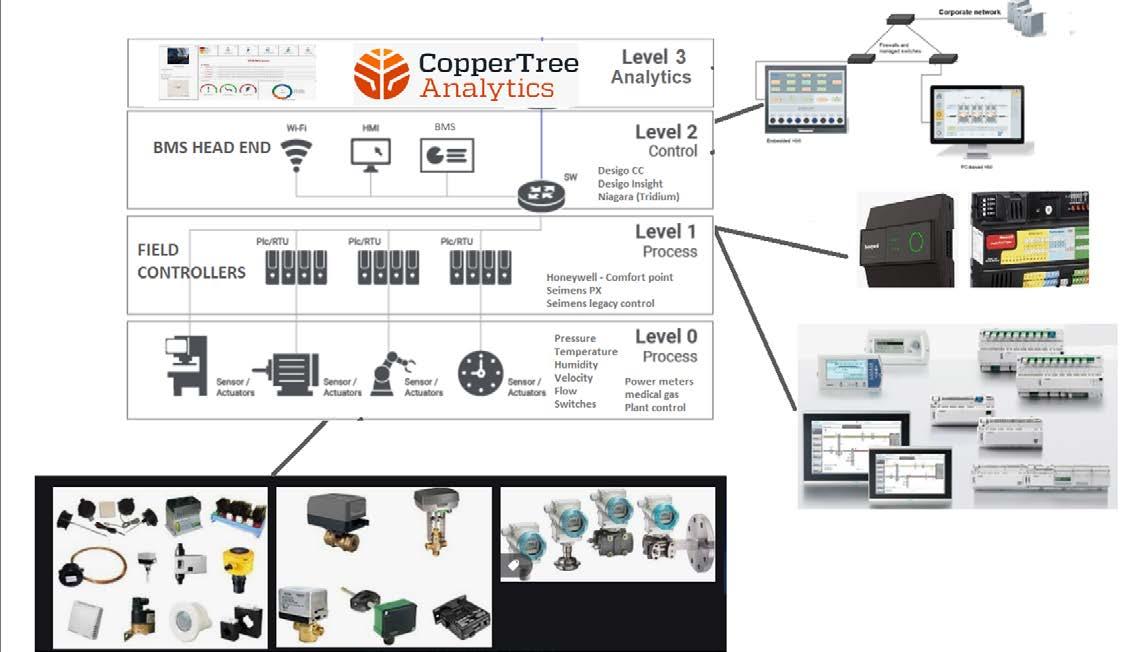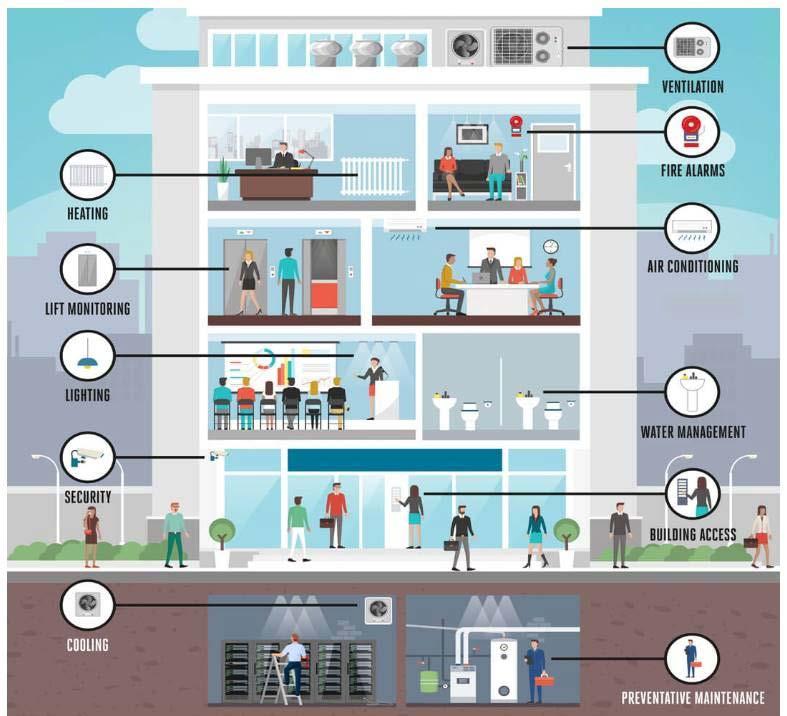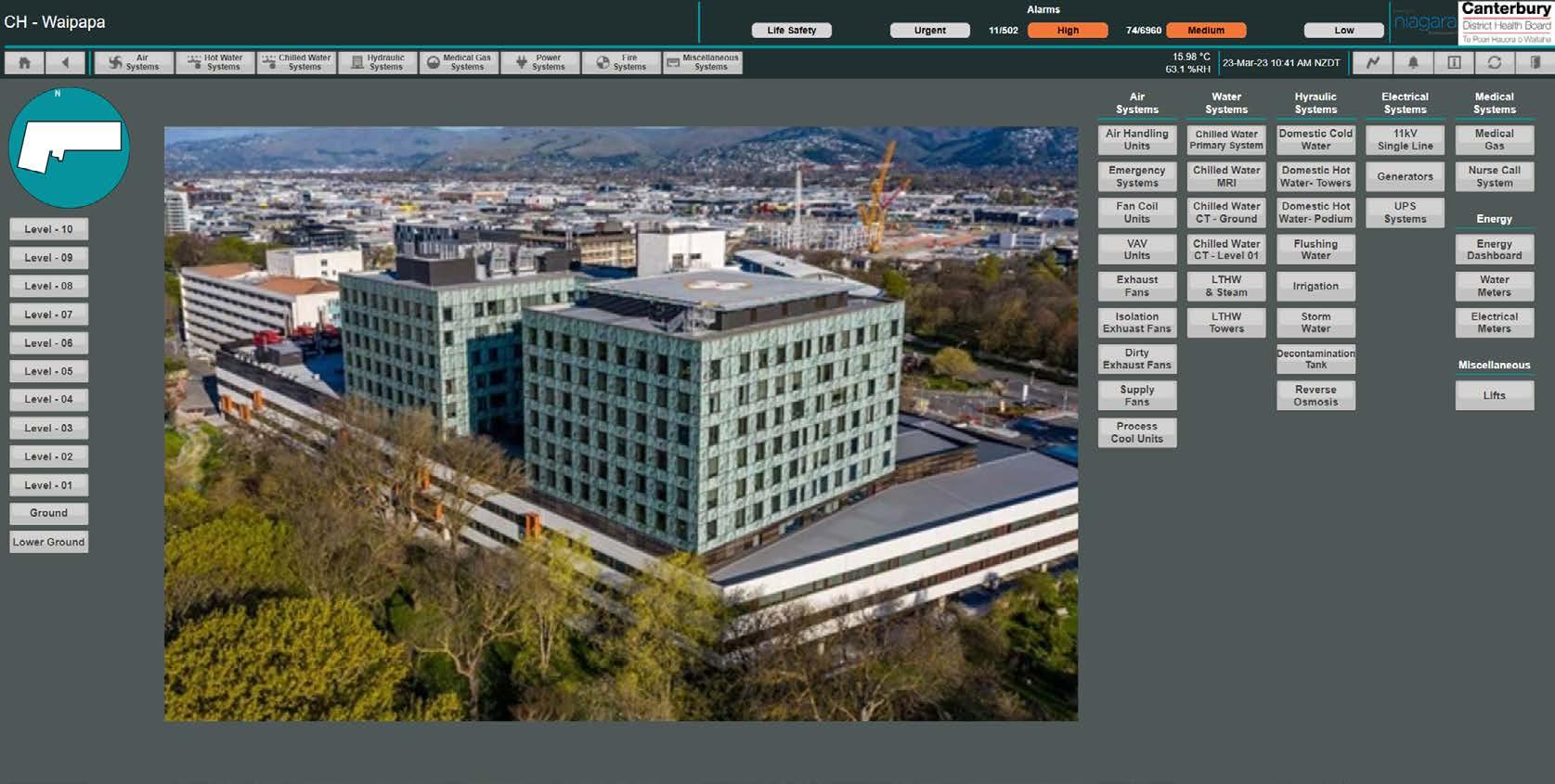
4 minute read
“State of the art” Building Management System
Te Whatu Ora Waitaha Canterbury is now operating a high-tech Building Management System (BMS) which is saving money and staff time.
The Tridium Niagara 4 architecture for our BMS is considered by many as one of the best, most flexible and innovative systems available, says Services Engineer Mark Byers. “What we have developed here in Waitaha would be a good benchmark for other Te Whatu Ora hospitals to compare to. I am confident that what we have is state of the art.”
Advertisement
Mark explored available systems over an 18 month period, looking at factors such as:
› Cost of ownership and support (Tridium is 58 percent cheaper than our former and other BMS systems)
› Reliability and ease of recovery after a failure (a simple SD card removal and replacement means we can get a site back up in less than one hour –previously it would be at least a week)
› Openness and use in health care and that could it be programmed in-house by our own Maintenance and Engineering (M&E) staff (now there is one person globally certified and others are in the pipeline).
“The objective is to reduce our human intervention and have technology work for us 24/7. We want the BMS to make automated decisions and provide our maintenance teams with ‘insights’ and direction. People leave and retire – a resilient BMS can capture useful people knowledge, add global best practice, and enable this knowledge to be used effectively moving forward," Mark says.
“We used to have a very reactive situation in M&E based upon the amount of BMS alerts we were getting. Now we have gone from about 3000 standing alarms to a manageable number of less than 100, and we can respond to this level effectively.
“Using one of the BMS’s analytics tools, it showed we could achieve savings of $28,000 a year in our Outpatients facility alone. We have implemented changes to release 70 percent of this and are working on the remainder now. “
The BMS team has just heard that the Energy Efficiency and Conservation Authority (EECA) will fund up to 40 percent of the BMS Coppertree Kaizen analytical software.

“This is gold, it means reduced Te Whatu Ora capital spend and with approvals we can now roll this out across remaining campuses,” Mark says.
Twenty-four hour shift engineer positions have been able to be replaced with standard eight-hours a day, Monday to Friday technician roles, with one person on-call after hours.
“We now have a more BMS technically focused staff. This means we can focus on things such as planned predictive maintenance, in-house programming of the BMS additions and in-house fault finding of complex BMS issues that previously we needed BMS specialists to help us with.”
“What these three points achieve is a measurable cost reduction in use of third-party fault-finding in the order of $80,000 plus a year. We can now apply approved operational expenditure on designing out the BMS fault conditions and eliminating these fault situations long term.”
Our organisation’s infrastructure is too large for manual control and to employ the staff to provide manual control effectively, he says.
“The BMS takes pressure off managers and staff to monitor data and adjust settings. The BMS has a single-user interface that saves people time by bringing relevant information and controls together in one place.”
The First Building Management System (BMS) was installed in Christchurch Hospital around 1999. Today, our BMS measures and monitors our Waitaha buildings and mechanical plant from Kaikōura to Akaroa and out to Ashburton. A smaller BMS monitors Te Tai Poutini West Coast’s Te Nīkau, Grey Hospital and Health Centre and Buller Health.
What is a BMS?

A BMS is a distributed suite of software and hardware that enables control and monitoring of our hospital’s infrastructure systems. It allows real-time monitoring and optimisation of infrastructure, managing patient and staff safety by controlling air flow and providing a comfortable environment. The BMS also provides notification of any faults or abnormal situations before patient and staff environments are compromised.


Waitaha Canterbury’s BMS is designed around the Purdue model (shown right).
It manages utilities such as heating, cooling, air, and electrical power, mechanical plant such as water and waste management, heat pumps, energy recovery, medical gas bulk storage and distribution, and air extraction systems – to name just a few.
It also controls room temperature and humidity, CO2 levels, lighting management, fire systems monitoring, lift monitoring, alerts and much more. Analytical software hosted in secure cloud-based global systems alert maintenance teams to any abnormal conditions.
A BMS has performance management and reporting capabilities, to meet energy consumption and energystar™ rating targets. It can quickly translate real-time data for rapid decision-making, enabling early identification of equipment failure.
Buildings can become less efficient as operational patterns change and equipment performance declines. A BMS can implement diagnostics for most heating, ventilation, and air conditioning components, and detect when a component is starting to fail. Operators can be alerted to begin preventative maintenance.
A web-enabled BMS can anticipate favourable or extreme weather conditions and adjust heating cooling and ventilation sequences for the most efficient outcome. For example, if the BMS anticipates a hotter than normal day, it can automatically pre-cool the building to take advantage of off-peak energy.

Why do we use a BMS and how does it help our staff and patients?
BMS allows control and optimisation of infrastructure to create the environments required by staff, and patients.
Energy-saving strategies that can be enabled include:
› precise start-up and run times

› economy cycle including CO2 occupancy control
› adjusting for seasonal conditions, including variable plant sequence selection
› air pressure and coolant temperature control.
› the BMS can also flag excessive energy use, such as equipment left on when not needed.








